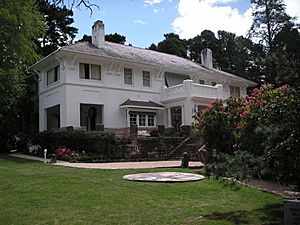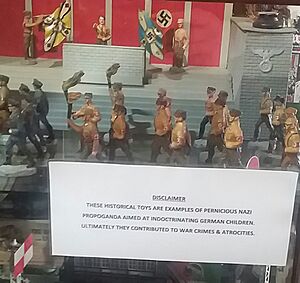Leuralla facts for kids
Quick facts for kids Leuralla |
|
|---|---|
 |
|
| General information | |
| Type | House |
| Architectural style | Federation Free Classical |
| Location | 36 Olympian Parade Leura, New South Wales |
| Coordinates | 33°43′29″S 150°19′47″E / 33.7246°S 150.3297°E |
| Construction started | 1910 |
| Completed | 1914 |
| Governing body | The Evatt Family |
| Design and construction | |
| Architect | Edward Hewlett Hogben (1875–1936) |
Leuralla is a special old house located in Leura. This town is in the beautiful Blue Mountains of New South Wales, Australia. For many years, Leuralla was home to the Leuralla Toy & Railway Museum. This fun museum closed its doors in 2022.
The house you see today was built between 1910 and 1914. It was designed by an architect named Edward Hewlett Hogben. The large garden around the house is about 5 hectares (12 acres) big. It was first designed by Harry Andreas and later improved by Paul Sorensen. There's even an outdoor theatre, called an amphitheatre, that looks out over the amazing Jamison Valley.
Contents
The History of Leuralla
Leuralla was built for a wealthy man named Harry Andreas (1879–1955). He loved sailing and fishing for big fish. Harry and his wife, Alice, lived at Leuralla until after World War II.
In 1928, their daughter Marjorie married Clive Evatt (1900–1984). This started the Evatt family's connection to the property. Later, Clive Evatt Jnr, who was Harry Andreas's grandson, helped manage Leuralla. Clive Evatt Jnr and his wife, Elizabeth Evatt, are the people who started the museum there. They put together the collections of toys, trains, and items belonging to H.V. Evatt (1894–1965). H.V. Evatt was Clive Evatt Snr's brother, a famous Australian politician. He had his own home in Leura and was not directly connected to Leuralla house itself.
The House and Its Buildings
An earlier house called Leuralla was built on this spot in 1903. Sadly, it was destroyed by a bushfire in 1909. The current house was then built between 1910 and 1914. Its design was inspired by the famous architect Frank Lloyd Wright.
This grand two-storey house shows what a wealthy family's home looked like in the early 1900s. It is built in the Federation Free Classical style. You can notice its impressive entrance, called a portico, and its balanced design. The walls and chimneys are smooth, and the house sits on a base of rough sandstone.
Leuralla has a sloped roof with smaller sloped sections on the sides. A wide sandstone staircase leads up to the front door. This staircase has two parts that meet under the portico. On top of the portico is a balcony with a railing. The entrance has Doric columns, which are a type of classical pillar. The front door has many glass panes and side windows. The roof is covered with slate tiles and has terracotta ridges.
There is also a garage with a unique style, and a small sandstone building with a pointed roof on the property.
The Amazing Garden
Harry Andreas started creating a beautiful garden at Leuralla very early on. Much of it was saved from the 1909 bushfire. The garden was then redeveloped around the new house built in 1914. It is still very large, covering 5 hectares (12 acres).
Harry Andreas first used a formal garden design. Later, Paul Sorensen made even more improvements to the garden. There is also a special sculpture garden on one side of the property. The amphitheatre, or outdoor theatre, is built right on the edge of the cliff. It offers amazing views overlooking the Jamison Valley.
Famous Visitors
In the 1930s, Leuralla was the home of the Katoomba Music Society. This meant many interesting musicians visited the house. These guests included the world-famous pianist Solomon Cutner, known as The Great Solomon. Also, the composer and conductor Sir Eugene Goossens visited. Another guest was the music critic and cricket commentator Sir Neville Cardus.
In 1927, Harry Andreas even helped guide The Duke and Duchess of York on a fishing trip. They later became King George VI and Queen Elizabeth, the parents of Queen Elizabeth II.
The Toy and Railway Museum
Leuralla was home to a toy museum from 1980 until 2022. It had a huge collection of toys, children's books, games, and models from the 20th Century. Some of the items included rare metal trains, airplanes, airships, ships, and cars. There were also figures made of lead and other materials. The museum featured working model train sets with tiny train stations, harbours, farms, and even military scenes.
Many popular characters were represented in the collection. These included Alice in Wonderland, Tintin, Babar, Winnie the Pooh, Noddy, and Rupert Bear. There were also toys of Popeye, James Bond, Action Man, Barbie, and Harry Potter. Important dolls, teddy bears, and stuffed animals were on display. You could also find Meccano sets, building kits, games, jigsaws, children's books, and comics.
Outside, the museum had a display of model trains. There were also original items from New South Wales railways, like old signs, benches, and station equipment. These items were saved from being thrown away in the 1980s. The house also had a special museum section dedicated to Dr. H. V. Evatt, a very important Australian politician and thinker.
The museum also included a display of Nazi-themed toys. These toys were used in Germany during the Nazi era to teach children their ideas. A sign at the display clearly stated that the museum "disclaims and condemns" such use. It explained that the toys were shown for public knowledge and to understand history. When the museum closed in 2022, these specific Nazi-themed toys were not included in the sale of the rest of the collection.
See also
- National Transport and Toy Museum in Wānaka, New Zealand
- Nuremberg Toy Museum


